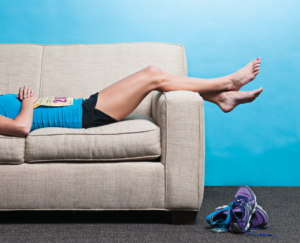
Recovery: The Forgotten Training Component
There is no shortage of products, video-based workout programs or gimmicks “guaranteed” to help you get results from exercise. Did you know that there is something that you’re probably already doing that can have a positive effect on your exercise program, but you’re more than likely just not doing enough of it?
No, it’s not more cardio for “fat burning,” it’s not mind-body exercises to create “balance” and it’s certainly not more resistance training for a metabolic “burn.” In fact, it has nothing at all to do with exercise, and yet is one of the most important components of a total wellness program that can help improve your overall health and fitness levels—recovery.
From Insanity to indoor cycling classes to Cross Fit, high-intensity workouts have been all the rage in the fitness industry over the past few years, and with good reason…they work. Exercising at maximal intensity will burn more calories and increase the levels of the hormones that stimulate fat burning and promote muscle growth. However, the best workout program in the world won’t create the effect you want if you don’t get the proper rest and allow the appropriate time for your body to recover from the exercise. In fact, training too hard, too often, with little recovery can actually be bad for you and lead to Overtraining Syndrome, which could cause weight gain, sleeplessness, poor immune system function and other physiological issues that can keep you from reaching your fitness goals.
Top strength coaches and personal trainers know that the secret to getting results from exercise isn’t in the workout itself, but rather what happens during the recovery period post-workout. Whether it’s mechanical stress (to the muscle tissue) in the form of weightlifting or metabolic stress (to the cardiorespiratory system), exercise disrupts the body’s homeostasis with an external stimulus. The workout session is when a physical stimulus is applied to the body, but it is the rest and recovery period AFTER the workout that determines how the body will adapt to the stimulus.
Volume is the total amount of exercise performed in a program. In weightlifting programs, volume is the product of the intensity (amount of weight used), the number of repetitions and the total number of sets. Volume for cardiorespiratory exercise refers to the combination of running pace, distance and time. It doesn’t matter whether the exercise is lifting weights or running (or any other mode of cardiovascular exercise); generally speaking, higher-intensity workouts require a longer period of post-workout recovery to allow the body to properly recover from and adapt to the exercise stress.
Sleep is one of the most important components of an effective recovery program. During sleep, the body produces the hormones responsible for stimulating muscle protein synthesis, which is critical for repairing muscle tissue. On the days that you plan on doing a high-intensity workout, make sure that you have the ability to get a full night’s sleep so you can be fully recovered before your next workout. For best results, allow approximately two days between high intensity workouts for full muscle recovery.
It is possible, and advisable to exercise every day, but the best way to ensure results and avoid the dangers of OTS is to alternate between high-, low- and medium-intensity days, and a practice known as undulating periodization.
Another way to think of OTS is that the body is under-recovered. Strength coaches meticulously schedule rest and recovery days to ensure their athletes are well rested before competition because they know it will help them perform at their best. The U.S. Olympic Training Centers provide specific recovery plans to complement their athletes’ training programs. If recovery plans are effective for athletes getting paid millions of dollars or competing for a gold medal, then having an effective recovery plan and allowing proper rest between workouts could provide that extra edge you need to achieve your fitness goals.



Comments are closed.